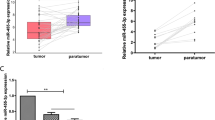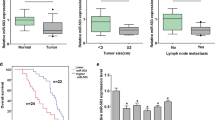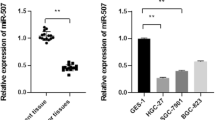Abstract
Aberrant activation of the Wnt/β-catenin signaling pathway plays a major role in carcinogenesis and the progression of many malignant tumors, especially gastric cancer (GC). Some research has suggested that expression of the β-catenin protein is associated with clinicopathologic factors and affects the biological behaviors of GC cells. However, the mechanism of these effects is not yet clear. Studies show that the Wnt/β-catenin pathway regulates some miRNAs. We hypothesize that oncogenic activation of β-catenin signaling is involved in the formation of GC through regulating certain microRNAs (miRNAs). The results of the current study demonstrate that expression of the β-catenin protein is associated with many clinicopathologic characteristics including the degree of differentiation, depth of tumor invasion, tumor site, and 5-year survival rate. We found that silencing the expression of β-catenin with lentiviruses could delay cell proliferation, promote apoptosis, weaken the invasive power of GC cells, and increase the sensitivity of GC cells to 5-fluorouracil in vitro. Using miRNA microarrays to detect changes in the miRNA transcriptome following interference with β-catenin in GC cells, we found that miR-1234-3p, miR-135b-5p, miR-210, and miR-4739 were commonly upregulated and that miR-20a-3p, miR-23b-5p, miR-335-3p, miR-423-5p, and miR-455-3p were commonly downregulated. These data provide a theoretical basis for the potential interaction between miRNA and the β-catenin signaling pathway in GC.






Similar content being viewed by others
References
Jemal A, Bray F, Center MM, Ferlay J, Ward E, et al. Global cancer statistics. CA Cancer J Clin. 2011;61(2):69–90.
Guilford P, Hopkins J, Harraway J, McLeod M, McLeod N, et al. E-cadherin germline mutations in familial gastric cancer. Nature. 1998;392(6674):402–5.
Stadtlander CT, Waterbor JW. Molecular epidemiology, pathogenesis and prevention of gastric cancer. Carcinogenesis. 1999;20(12):2195–208.
Clevers H, Nusse R. Wnt/beta-catenin signaling and disease. Cell. 2012;149(6):1192–205.
Kim B, Byun SJ, Kim YA, Kim JE, Lee BL, et al. Cell cycle regulators, APC/beta-catenin, NF-kappaB and Epstein-Barr virus in gastric carcinomas. Pathology. 2010;42(1):58–65.
Woo DK, Kim HS, Lee HS, Kang YH, Yang HK, et al. Altered expression and mutation of beta-catenin gene in gastric carcinomas and cell lines. Int J Cancer. 2001;95(2):108–13.
Clements WM, Wang J, Sarnaik A, Kim OJ, MacDonald J, et al. beta-Catenin mutation is a frequent cause of Wnt pathway activation in gastric cancer. Cancer Res. 2002;62(12):3503–6.
Esquela-Kerscher A, Slack FJ. Oncomirs—microRNAs with a role in cancer. Nat Rev Cancer. 2006;6(4):259–69.
Bartel DP. MicroRNAs: genomics, biogenesis, mechanism, and function. Cell. 2004;116(2):281–97.
Spizzo R, Nicoloso MS, Croce CM, Calin GA. SnapShot: microRNAs in cancer. Cell. 2009;137(3):586–586 e1.
Martello G, Zacchigna L, Inui M, Montagner M, Adorno M, et al. MicroRNA control of nodal signalling. Nature. 2007;449(7159):183–8.
Kapinas K, Kessler CB, Delany AM. miR-29 suppression of osteonectin in osteoblasts: regulation during differentiation and by canonical Wnt signaling. J Cell Biochem. 2009;108(1):216–24.
Kapinas K, Kessler C, Ricks T, Gronowicz G, Delany AM. miR-29 modulates Wnt signaling in human osteoblasts through a positive feedback loop. J Biol Chem. 2010;285(33):25221–31.
Schepeler T, Holm A, Halvey P, Nordentoft I, Lamy P, et al. Attenuation of the beta-catenin/TCF4 complex in colorectal cancer cells induces several growth-suppressive microRNAs that target cancer promoting genes. Oncogene. 2012;31(22):2750–60.
Wang X, Lam EK, Zhang J, Jin H, Sung JJ. MicroRNA-122a functions as a novel tumor suppressor downstream of adenomatous polyposis coli in gastrointestinal cancers. Biochem Biophys Res Commun. 2009;387(2):376–80.
Bienz M, Clevers H. Linking colorectal cancer to Wnt signaling. Cell. 2000;103(2):311–20.
Khramtsov AI, Khramtsova GF, Tretiakova M, Huo D, Olopade OI, et al. Wnt/beta-catenin pathway activation is enriched in basal-like breast cancers and predicts poor outcome. Am J Pathol. 2010;176(6):2911–20.
Uren A, Fallen S, Yuan H, Usubutun A, Kucukali T, et al. Activation of the canonical Wnt pathway during genital keratinocyte transformation: a model for cervical cancer progression. Cancer Res. 2005;65(14):6199–206.
Tanaka S, Arii S. Molecular targeted therapies in hepatocellular carcinoma. Semin Oncol. 2012;39(4):486–92.
Li LF, Wei ZJ, Sun H, Jiang B. Abnormal beta-catenin immunohistochemical expression as a prognostic factor in gastric cancer: a meta-analysis. World J Gastroenterol. 2014;20(34):12313–21.
Cheng XX, Wang ZC, Chen XY, Sun Y, Kong QY, et al. Correlation of Wnt-2 expression and beta-catenin intracellular accumulation in Chinese gastric cancers: relevance with tumour dissemination. Cancer Lett. 2005;223(2):339–47.
Jawhari A, Jordan S, Poole S, Browne P, Pignatelli M, et al. Abnormal immunoreactivity of the E-cadherin-catenin complex in gastric carcinoma: relationship with patient survival. Gastroenterology. 1997;112(1):46–54.
Pirinen RT, Hirvikoski P, Johansson RT, Hollmen S, Kosma VM. Reduced expression of alpha-catenin, beta-catenin, and gamma-catenin is associated with high cell proliferative activity and poor differentiation in non-small cell lung cancer. J Clin Pathol. 2001;54(5):391–5.
Imura J, Ichikawa K, Takeda J, Fujimori T. Beta-catenin expression as a prognostic indicator in cervical adenocarcinoma. Int J Mol Med. 2001;8(4):353–8.
Lu W, Jia G, Meng X, Zhao C, Zhang L, et al. Beta-catenin mediates the apoptosis induction effect of celastrol in HT29 cells. Life Sci. 2012;91(7–8):279–83.
Moon RT, Bowerman B, Boutros M, Perrimon N. The promise and perils of Wnt signaling through beta-catenin. Science. 2002;296(5573):1644–6.
Dang CV, O’Donnell KA, Zeller KI, Nguyen T, Osthus RC, et al. The c-Myc target gene network. Semin Cancer Biol. 2006;16(4):253–64.
Shtutman M, Zhurinsky J, Simcha I, Albanese C, D’Amico M, et al. The cyclin D1 gene is a target of the beta-catenin/LEF-1 pathway. Proc Natl Acad Sci U S A. 1999;96(10):5522–7.
Baldin V, Lukas J, Marcote MJ, Pagano M, Draetta G. Cyclin D1 is a nuclear protein required for cell cycle progression in G1. Genes Dev. 1993;7(5):812–21.
Geho DH, Bandle RW, Clair T, Liotta LA. Physiological mechanisms of tumor-cell invasion and migration. Physiology (Bethesda). 2005;20:194–200.
Brabletz T, Jung A, Dag S, Hlubek F, Kirchner T. Beta-catenin regulates the expression of the matrix metalloproteinase-7 in human colorectal cancer. Am J Pathol. 1999;155(4):1033–8.
Sprio AE, Di Scipio F, Ceppi P, Salamone P, Di Carlo F, et al. Differentiation-inducing factor-1 enhances 5-fluorouracil action on oral cancer cells inhibiting E2F1 and thymidylate synthase mRNAs accumulation. Cancer Chemother Pharmacol. 2012;69(4):983–9.
Stein U, Fleuter C, Siegel F, Smith J, Kopacek A, et al. Impact of mutant beta-catenin on ABCB1 expression and therapy response in colon cancer cells. Br J Cancer. 2012;106(8):1395–405.
He XP, Shao Y, Li XL, Xu W, Chen GS, et al. Downregulation of miR-101 in gastric cancer correlates with cyclooxygenase-2 overexpression and tumor growth. FEBS J. 2012;279(22):4201–12.
Zhou L, Qiu T, Xu J, Wang T, Wang J, et al. miR-135a/b modulate cisplatin resistance of human lung cancer cell line by targeting MCL1. Pathol Oncol Res. 2013;19(4):677–83.
Golubovskaya VM, Sumbler B, Ho B, Yemma M, Cance WG. MiR-138 and MiR-135 directly target focal adhesion kinase, inhibit cell invasion, and increase sensitivity to chemotherapy in cancer cells. Anticancer Agents Med Chem. 2014;14(1):18–28.
Tavazoie SF, Alarcon C, Oskarsson T, Padua D, Wang Q, et al. Endogenous human microRNAs that suppress breast cancer metastasis. Nature. 2008;451(7175):147–52.
Xu Y, Zhao F, Wang Z, Song Y, Luo Y, et al. MicroRNA-335 acts as a metastasis suppressor in gastric cancer by targeting Bcl-w and specificity protein 1. Oncogene. 2012;31(11):1398–407.
Liu W, Zabirnyk O, Wang H, Shiao YH, Nickerson ML, et al. miR-23b targets proline oxidase, a novel tumor suppressor protein in renal cancer. Oncogene. 2010;29(35):4914–24.
Zaman MS, Thamminana S, Shahryari V, Chiyomaru T, Deng G, et al. Inhibition of PTEN gene expression by oncogenic miR-23b-3p in renal cancer. PLoS One. 2012;7(11), e50203.
Li X, Zhang Z, Yu M, Li L, Du G, et al. Involvement of miR-20a in promoting gastric cancer progression by targeting early growth response 2 (EGR2). Int J Mol Sci. 2013;14(8):16226–39.
Acknowledgments
The present study was supported by the JiangXi Province Talent 555 Project and the National Natural Science Foundation of China (nos. 81160281 and 81441083).
Conflicts of interest
None
Author information
Authors and Affiliations
Corresponding author
Additional information
Li Dong and Jun Deng contributed equally to this work.
Rights and permissions
About this article
Cite this article
Dong, L., Deng, J., Sun, ZM. et al. Interference with the β-catenin gene in gastric cancer induces changes to the miRNA expression profile. Tumor Biol. 36, 6973–6983 (2015). https://doi.org/10.1007/s13277-015-3415-1
Received:
Accepted:
Published:
Issue Date:
DOI: https://doi.org/10.1007/s13277-015-3415-1




